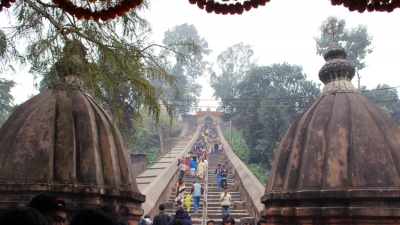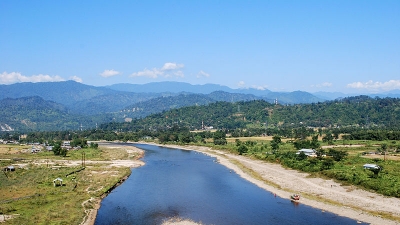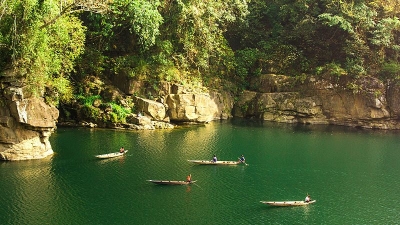Kaziranga Attractions - Tourist Places To Visit In Kaziranga
-
01Kaziranga National Park
+ Read MoreKaziranga National Park is one of the prides of Assam. It is noteworthy to mention that it is home to the endangered Indian one-horned rhinoceros and also declared as a tiger reserve in 2006, hosting the highest density of tigers in the world.
The national park is also a UNESCO World Heritage Site. It is a large park covering an approximate area of 429.93 sq km. It falls under two districts of Assam – Golaghat and Noagaon districts. Kaziranga tourism is not just about spotting one of the many one-horned rhinoceros or tigers that gracefully trudge the large grounds, but also to see the three large herbivores that live in the park, namely, the Asiatic Elephant, the Asiatic Water Buffalo and the Swamp Deer.
The Kaziranga National Park has also been demarcated as an important bird-area by the Birdlife International for its effort to conserve avifaunal species. One of the many attractions in the Kaziranga National Park is travelling inside the park on elephants that are steered by trained mahouts.
It is a special treat to move in the open grounds on these majestic animals. The other alternative of seeing the national park is on booked jeeps or 4WD vehicles. These have to be booked in advance from the Park Administrative Centre.
-
02Panbari Reserve Forest
 + Read More
+ Read MorePanbari Reserve Forest is located close to the Kaziranga National Park and falls under the Golaghat district. In the Panbari Reserve Forest, many exotic birds can be seen such as the Crested Goshawk, the Great Indian Hornbill etc.
There are several uncharted areas within the forest and tourists can take the help of forest guards and guides to reach these areas. A guide has to be hired from the base known as Kohara. It approximately takes two hours to see the entire forest.
In the forest, which is spread over an approximate area of 10 sq km, one can expect to also spot the Speckled Piculet, Pied Falconet and the Crow Billed Drongo. It is one of the few remaining highland forest areas of Kaziranga today.
Tourists can also enjoy a panoramic view of the Numaligarh Tea Estate from the Panbari Reserve Forest. While visiting the national park, one must also visit the Panbari Reserve Forest.
-
03Tea Gardens
 + Read More
+ Read MoreTea gardens are the pride of Assam. Assam tea is famous for its flavour and colour. While on a visit to the Kaziranga National Park, tourists must make it a point to visit a few tea gardens located closeby. The lush green small bushes rolling down the hills are a sight that everyone should witness once in a lifetime.
Many of these tea gardens welcome tourists warmly and open the estates for public viewing. The most prominent tea gardens near the national park are the Methoni, Hathkhuli, Difalu, Borchapori and Behora tea gardens.
While it is possible to go on a day-visit to these tea gardens, some of the tea gardens also have the facility for night stays. For tourists visiting the national park for a few days, a night stay at a tea garden is a good idea. Most of the tea gardens are closely located to the park and travelling to them isn’t difficult.
-
04Deoparbat Ruins
 + Read More
+ Read MoreDeoparbat Ruins, KazirangaDeoparbat Ruins is located 5 km from Numaligarh in Golaghat District and is close to the Kaziranga National Park. Also known as the Deopahar (two hills), the Deoparbat Ruins is famous for the archaeological ruins on top of a hill. There is an ancient temple at the top of the hills with broken statues scattered all around. These broken statues give an insight into how old the temple is. Climbing the Deopahar is quite tiring especially on a hot day. But once atop, the sight is mind-blowing.
Tourists can also catch a glimpse of the Numaligarh tea estate from the hilltop and also the nearby Kabi Anglong hills. Numaligarh is particularly famous for the Numaligarh Oil Refinery. Taxis can be easily booked from Kaziranga National Park to reach the Deoparbat Ruins in Numaligarh. Tourists can club a few destinations in the Golaghat district while on a day trip to the nearby attractions.
-
05Kakochang Waterfalls
 + Read More
+ Read MoreThe Kakochang Waterfalls is located 13 km from Bokakhat in Golaghat district, Assam. It is a beautiful waterfall that is tucked away in nature’s paradise. The waterfall comes cascading down in between the coffee and rubber plantations of the district making a scene breathtakingly beautiful.
The Kakochang waterfall is a popular picnic spot and frequented by locals and tourists alike. There is a lot of space around the lake that is ideal for picnickers. One can see the ancient ruins in Numaligarh from the Kakochang waterfall. These ancient ruins are of great archaeological value.
Tourists visiting Kaziranga National Park can easily plan a day visit to the Kakochang Waterfalls while visiting the Deoparbat ruins at Numaligarh. Bokakhat is just 23 km from the national park. The best time to visit the waterfalls is during the post-monsoon months, when due to the heavy rainfall the waterfall plummets with abundant water.
-
06Kalyani Mandir
 + Read More
+ Read MoreKalyani Mandir is located at Dipora in Golaghat District. Dipora falls under the Halem Revenue Circle. It is a temple dedicated to Goddess Kalyani. It is believed that King Arimatta had built this small yet auspicious temple in honour of Goddess Kalyani, a manifestation of Goddess Shakti, a benevolent form of Goddess Durga.
There is nothing extraordinary about the architecture of the temple. It looks quite non-descriptive and simple. The temple resembles a typical Assamese Namghar. However, many devotees visit the temple mainly due to religious beliefs. Since the Kalyani Mandir is located quite close to the Kaziranga National Park, tourists prefer visiting the temple.
If you want to visit the Kalyani Mandir during your stay at the national park, you can plan a combined trip to several attractions in the Golaghat district on the same day. Fortunately there are several places to visit in this district.
-
07Madhabdev Thaan
 + Read More
+ Read MoreMadhabdev Thaan is the birthplace of Sri Sri Madhabdev, the most ardent disciple of Srimanta Sankardeva. The Madhabdev Thaan is also known as Leteku Pukhuri, situated near the Borbali village, under the Lakhimpur district of Assam. Sri Sri Madhabdev was born in the year 1489 and is considered as an important preceptor of the Vaishnavite culture in Assam.
Apart from being the most loyal disciple of Srimanta Sankardeva, Sri Sri Madhabdev is also known for his artistic brilliance. After Srimanta Sankardeva’s death, the Vaishnavites of Assam followed Sri Sri Madabdev as their religious Guru.
Sri Sri Madhabdev is particularly famous for giving the ‘Borgeets’ or the religious hymns that are till today recited and sung in the Namghars. The Madhabdev Thaan has a huge collection of holy books, cultural heritages and ancient manuscripts from the days of Sri Sri Madhabdev. These rare artifacts are open for the tourists to take a look at them.
-
08Petua-Gosani Thaan
 + Read More
+ Read MorePetua-Gosani Thaan is an old temple in this part of the region. The locals worship Goddess Kali and the temple is one of the oldest places where the goddess is still worshipped. The locals pray to Goddess Kali as Kesaikhaiti.
There is an interesting story relating to the British invasion of the Lakhimpur region and how they discovered this temple. It had taken the British quite some time to take control over the Lakhimpur region.
While they were establishing their rule over the area, they discovered the temple. It is believed that in the earlier days, the Daphala people now residing in Arunachal Pradesh, used to come to the Petua-Gosani Thaan for pilgrimage.
The Petua-Gosani Thaan is till today a celebrated and famous temple where Goddess Kali is worshipped. Every year, the locals celebrate the Durga Puja at the temple. The temple is not every far from Kaziranga National Park.
-
09Radha Pukhuri
 + Read More
+ Read MoreNarayanapur has several interesting attractions that tourists can visit while in Kaziranga National Park. One of them is the Radha Pukhuri at the Sawkuchi village. The tank is currently used by the Assam Government’s Fisheries Department for free breeding and cultivation.
It is believed that Radha Pukhuri was built sometime between 1400 and 1500 AD, though the exact year cannot be told. The Radha Pukhuri was built by King Lakhminarayan and he named the tank after his wife ‘Radha’.
Other historians, however, hold an opposing view that the tank was constructed by Queen Sarbeswari. The Radha Pukhuri was briefly known as Adhapukhuri, ‘Adha’ meaning half, as construction came to a halt halfway.
It was soon changed back to Radha Pukhuri. Narayanapur is located 34 km away from the national park. For tourists interested in visiting the Radha Pukhuri tank, they can easily reach Narayanapur in an hour’s time.
-
10Bhatoukuchi Thaan
 + Read More
+ Read MoreBhatoukuchi Thaan is a small temple located at the Kathani village near Dholpur, Narayanapur, in the Lakhimpur district of Assam. It is believed that the temple was built by Keshabsaran Bhatoukuchia Ataa and thus the name Bhatoukuchia Thaan.
According to Kahtagurucharit (ancient text), Keshabsaran was born in 1605 and died in 1665. This temple attracts a large number of tourists from all across Assam who come here to seek the blessings of the Almighty. It also attracts people from other parts of the country and the world who come for the famed Kaziranga trip.
The temple is spread amidst tea gardens and forest, making it a perfect setting for any tourist to get the real taste of Assam. The architecture of the temple gives us a glimpse into skills and craftsmanship of the people in Assam during the Ahom dynasty’s rule.
-
11Akadohia Pukhuri
 + Read More
+ Read MoreThe big tank (in the Assamese language ‘pukhuri’ stands for tank) is situated at the Kachua village near Dholpur. It is believed to have been named after a holy Brahmin guru called Akadoshi, who lived near the tank. It is said that the guru had divine powers and this made him very popular in the village and other neighbouring villages.
Even today the locals believe that their wishes would come true by praying near the tank. Hence the tank is sacred to the people of Kachua village and other nearby villages. This also makes Akadohia Pukhuri a very popular spot for the people visiting this place.
While some come with prayers in their heart, others come here to see the tank and get to know the culture of the people living around. The village setting offers you a perfect picture into the life of the people of a village in Assam.
-
12Gohpur
 + Read More
+ Read MoreGohpur is a town in the Sonitpur district of Assam. It is a small town but historically quite rich. It is in this town that the famous freedom fighter Kanaklata Barua was born. Kanaklata Barua was fondly called Birbala and she was shot dead during the Quit India Movement 1942 for carrying the National Flag.
Gohpur has a few places of interest such as the Dhandi Devalay, Gohpur Reserve Forest and Bor Pukhuri. Gohpur is just about 8 km from the outer fringes of Kaziranga National Park. While on a visit to the Kaziranga National Park, tourists can plan their itinerary in such a manner that they can visit Gohpur and be back to the park by evening.
Tourists can hire a taxi from the park to reach Gohpur. It is advisable that they book the car for the entire day so that they can return easily too.
-
13Maghnoa Doul
 + Read More
+ Read MoreMaghnoa Doul is located at the east of the Pichola River on the banks of the Maghnoa Beel. It is also known as the Phulbari Doul. Maghnoa Doul is embedded in history and thus a popular tourist destination close to Kaziranga.
It is believed that during the ancient times, the Maghnoa Doul was considered sacred as an idol of Goddess Kali was worshipped here. However, during the invasion of the Maan, the Goddess’s idol was hidden. The idol, however, was never returned to the doul again but installed in Deotala.
The Maghnoa Doul towers to a height of 75 ft and houses the Bulani Ghar, where the idol used to be enshrined. There is a 5 ft high wall that serves as the boundary to the doul. Once upon a time, there used to be several valuable sculptures and idols in the doul. But today none can be seen here as it is believed that the local people have stolen them.
-
14Bapuchang
 + Read More
+ Read MoreBapuchang is a Buddhist temple in the Khamti village, Narayanapur. It is situated in the Lakhimpur district of Assam. Bapuchang is located 34 km from the Kaziranga National Park. The temple is quite similar to other Buddha temples found around the world. This is the reason why the temple’s architecture is quite removed from the normal Khamti architecture seen in this part.
It has been seen that much of the outer architecture bears a resemblance to the Buddha Bihars found in Myanmar. There are several Buddha idols inside Bapuchang and sees a substantial number of devotees visiting this small Khamti village every year.
Its proximity to Kaziranga has further made it very popular. Tourists will find guided trips to Bapuchang as a part of a short trip to the adjoining areas of the national park.
-
15Deotala
 + Read More
+ Read MoreDeotala is the place where the recovered idol of Maghnao Doul is currently installed. During the Maan invasion, the ancient Maghnao Doul idol was hidden to prevent it from getting destroyed. This hidden idol was recovered from the Gavoru Beel in Kherajkhat. Once it was recovered, it was taken from Gavoru Beel and enshrined at Deotala which was formerly known as the Bor-Kalaika Thaan.
Deotala literally translates to – ‘Deo’ – god, ‘Tola’ – to lift. Deotala is about 8 km from Narayanapur in Lakhimpur district. Narayanapur is about 34 km from the Kaziranga National Park. The place doesn’t have elaborate architecture, or anything yet transcends normal expectations.
It is serene and beautiful in its own way. Devotees who visit the Maghnao Doul also make it a point to visit Deotala as it seems quite incomplete to visit the Doul and not see the idol. Maghnao Doul is also close to the Kaziranga National Park.



 Click it and Unblock the Notifications
Click it and Unblock the Notifications






